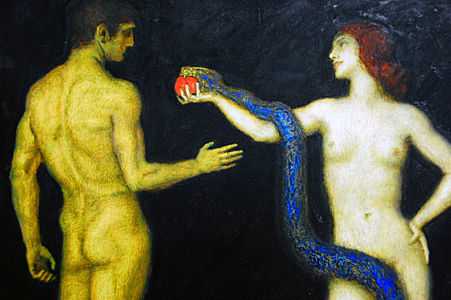Franz Stuck

Franz Stuck (February 23, 1863 – August 30, 1928), ennobled as Franz Ritter von Stuck in 1906, was a German symbolist/Art Nouveau painter, sculptor, engraver, and architect.
Life and career

Stuck was born at Tettenweis, in Bavaria. From an early age he displayed an affinity for drawing and caricature. To begin his artistic education he relocated in 1878 to Munich, where he would settle for life. From 1881 to 1885 Stuck attended the Munich Academy.
He first became well known by cartoons for Fliegende Blätter, and vignette designs for programmes and book decoration. In 1889 he exhibited his first paintings at the Munich Glass Palace, winning a gold medal for The Guardian of Paradise.

In 1892 Stuck co-founded the Munich Secession, and also executed his first sculpture, Athlete. The next year he won further acclaim with the critical and public success of what is now his most famous work, the painting The Sin. Also during 1893, Stuck was awarded a gold medal for painting at the World's Columbian Exposition in Chicago, and was appointed to a royal professorship. In 1895 he began teaching painting at the Munich Academy.
In 1897 Stuck married an American widow, Mary Lindpainter, and began work designing his own residence and studio, the Villa Stuck. His designs for the villa included everything from layout to interior decorations; for his furniture Stuck received another gold medal at the 1900 Paris World Exposition.
Having attained much fame by this time, Stuck was ennobled on December 9, 1905 and would receive further public honours from around Europe during the remainder of his life. He continued to be well respected among young artists as professor at the Munich Academy, even after his artistic styles became unfashionable. Notable students of his over the years include Paul Klee, Hans Purrmann, Wassily Kandinsky, Alf Bayrle and Josef Albers.

He was a member of the International Society of Sculptors, Painters and Gravers.[1]
Franz von Stuck died on August 30, 1928 in Munich; his funeral address memorialized him as "the last prince of art of Munich's great days". He is buried in the Munich Waldfriedhof next to his wife Mary.
Style
Stuck's subject matter was primarily from mythology, inspired by the work of Arnold Böcklin. Large forms dominate most of his paintings and indicate his proclivities for sculpture. His seductive female nudes are a prime example of popular Symbolist content. Stuck paid much attention to the frames for his paintings and generally designed them himself with such careful use of panels, gilt carving and inscriptions that the frames must be considered as an integral part of the overall piece.
Legacy
The number of Stuck's pupils who achieved great success served to enhance the teacher's own fame. Yet by the time of his death, Stuck's importance as an artist in his own right had almost been forgotten: his art seemed old-fashioned and irrelevant to a generation which had endured World War I. Stuck's reputation languished until the late 1960s when a renewed interest in Art Nouveau brought him to attention once more. In 1968 the Villa Stuck was opened to the public; it is now a museum.
In Robert Waite's book The Psychopathic God: Adolph Hitler and numerous other sources it is noted that Franz Stuck was Hitler's favorite painter from childhood on.
In this connection it is worth noting that Stuck made frequent use of the image of a woman wrapped by a serpent, a bondage image; Hitler was well known to be attracted to images of women in confinement. A British Intelligence report compiled on him noted that he appeared to only enjoy circus acts if they involved situations where a woman appeared to be in peril.
Stuck's works were never admitted to the Great German Art Exhibit.
One of Stuck's best-known paintings The Wild Chase depicts Wotan (Odin) on horseback leading a procession of the dead. It was completed about 1889, the year of Hitler's birth, and it has acquired a kind of semi-legendary status as the face of Wotan in the painting greatly resembles Hitler's.
Gallery
-

Dancers
-

The Guardian of Paradise
-
.jpg)
Wounded Amazon
-

The Struggle for Woman
-

Adam and Eve
-

Salome
Notes
 | |
|
|
- ↑ "The International Society of Sculptors, Painters and Gravers". Mapping the Practice and Profession of Sculpture in Britain and Ireland 1851-1951. Glasgow University. Retrieved 31 May 2013.
- ↑ "Stuck's The Sin". Smarthistory at Khan Academy. Retrieved March 28, 2013.
References
- Adam, Peter. "Art Of The Third Reich". New York: Harry N. Abrams. 1992. ISBN 0-8109-2615-6.
- Gibson, Michael. "Symbolism". Köln: Benedikit Taschen Verlag. 1995. ISBN 3-8228-9324-2.
- Mendgen, Eva. "Von Stuck". Köln: Benedikt Taschen Verlag. 1995. ISBN 3-8228-8888-5.
External links
| Wikimedia Commons has media related to Franz von Stuck. |
- Collection of Works by Franz von Stuck
- Museum Villa Stuck (in German)
- The Gallery Of Franz von Stuck
- Franz von Stuck: Living Images
- Grave of Mary and Franz von Stuck
|